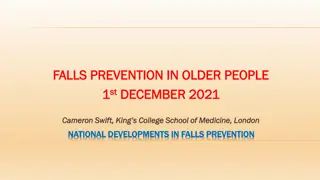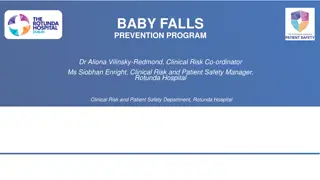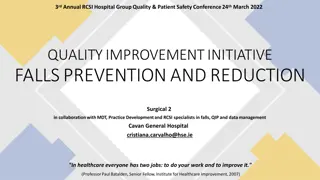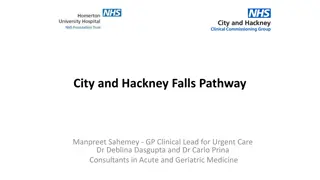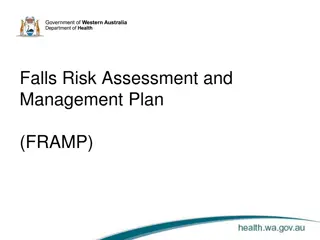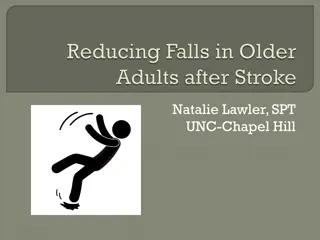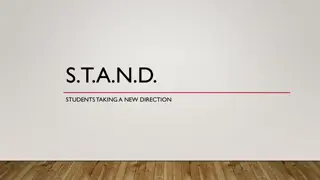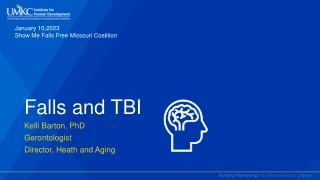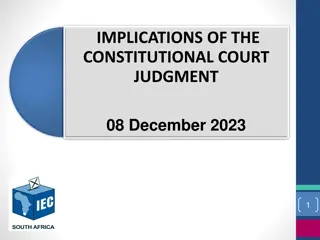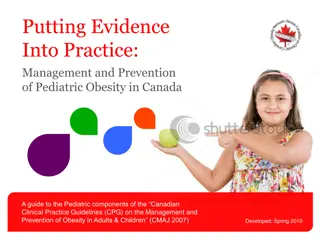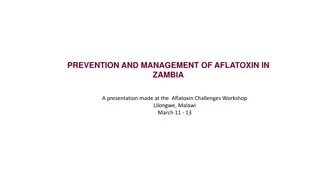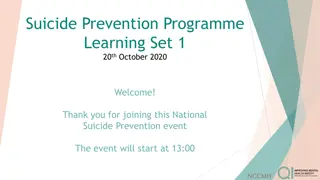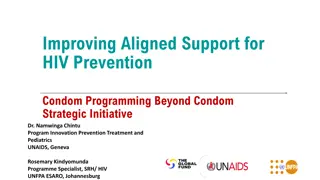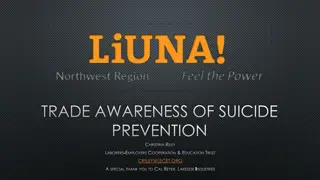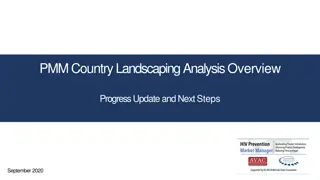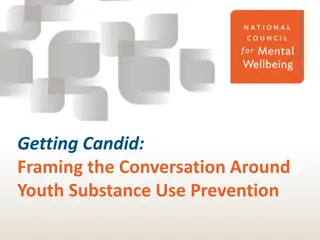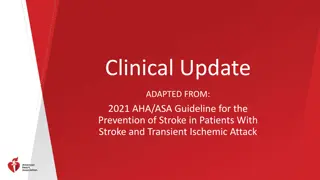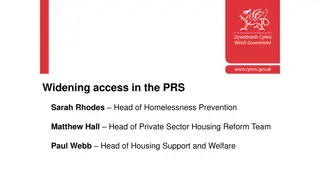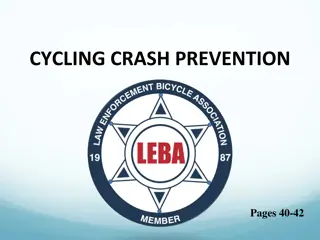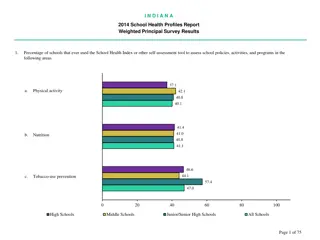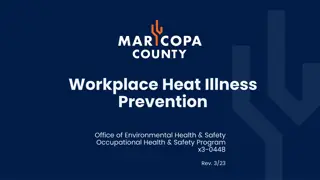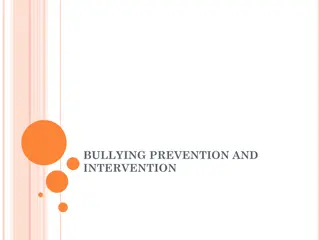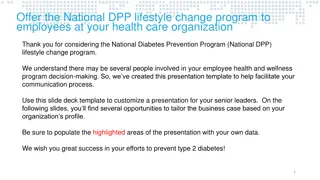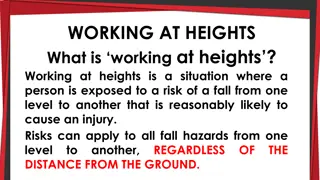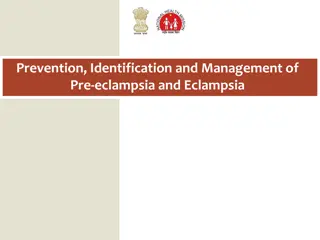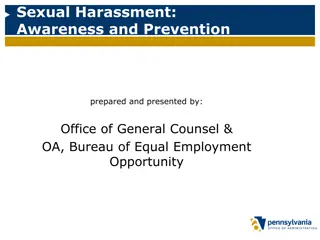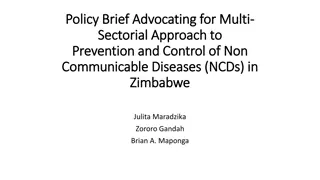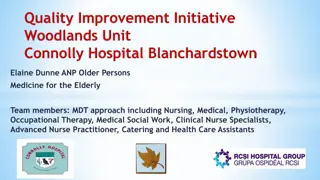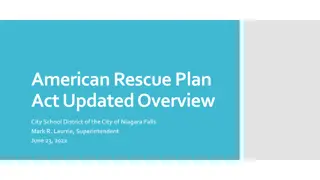Falls Prevention and Management in the UK: Challenges and Implications
Falls prevention is a crucial aspect of healthcare, particularly for older adults in the UK. With specific NICE guidelines in place, the focus is on conducting multifactorial risk assessments to mitigate falls risks. The prevalence of falls in hospitals presents significant safety concerns, leading to various injuries, fractures, and even fatalities. The impact of COVID-19 measures, such as shielding, has contributed to a projected increase in falls among older populations, highlighting the importance of ongoing efforts in strength training and balance activities to reduce health system costs and improve patient outcomes.
Download Presentation

Please find below an Image/Link to download the presentation.
The content on the website is provided AS IS for your information and personal use only. It may not be sold, licensed, or shared on other websites without obtaining consent from the author. Download presentation by click this link. If you encounter any issues during the download, it is possible that the publisher has removed the file from their server.
E N D
Presentation Transcript
Falls Prevention has a specific NICE guidance which tells us to undertake the multifactorial assessment , NICE CG 161 Falls in Older People This requires all patients aged over 65 years to have a multifactorial falls risk assessment. With clinical judgement for patients aged over 50 years
NICE CG 109 Transient Loss of consciousness in adults and younger people NICE 103 Delirium NICE 176 Head Injury NICE 146 Fragility Fracture NICE QS 86 Falls in older people
Falls in hospitals are the most commonly reported patient safety incident with more than 240,000 reported in acute and mental health trusts in England & Wales RCP, 2015, Falling Standards broken promises
Nearly 100,000 patients suffer bruises, grazes, lacerations or more serious injuries Over 800 hip fractures and around 600 other fractures are reported each year. 130 deaths associated with falls in hospital were also reported The cost of treating falls in hospitals in the UK has been estimated at between 15 million and 87 million per year NRLS 2014
The older adults in the UK were advised to shield from March 2020 A publication called Wider impacts of COVID-19 on physical activity, deconditioning and falls in older adults was released by Public Health England in August 2021, this analysis the effect of shielding
110,000 more older people will fall per year, an increase of 3.9% The total number of falls for males could increase by 124,000, an increase of 6.3% The total number of falls for females could increase by 130,000 an increase of 4.4%
For each year that the lower levels of strength and balance activity observed during the pandemic persist, there is projected to be an additional cost to the health and social care system as a result of the change in predicted related falls of 211 million (incurred over a 2 and half year period)
Use your own data to benchmark yourself, it s not a competition Be aware of in-patient differences between areas Covid 19 has changed a lot of previous data and is not comparible
Broomfield data evidences that falls rates for night & day were 50:50 pre covid. During 2020-1 year that changed to 68% of falls at night Now in Q2 2021/2 there has been a change in the percentages to 47% at night and 53% during the day So what has changed?
Covid +/- hypoxia Climatic such as temperature Outlier Unplanned environmental changes, such as emergencies, other patients, new admissions Locum/agency staffing Greenwich Mean Time V British Summer Time ( falls used to be 30% less in the summer), longer nights in the winter
Staffing levels Break times Drug rounds Layout of the area Lighting Shift times
Attribution theory involves trying to understand and explain the causes of behaviour we observe in others Example incident report state patient slipped whilst using the bottle at the bedside 04.00 hours This is where a robust SBAR reporting and questioning system pulls out vital information
One of the biggest motivators for patients to walk on the wards Are they visible and accessible? Have you chairs outside for a tired patient to wait their turn on? Has an OT checked out the environment for how easily a patient can wash/shower/get dressed/toilet Dignified Throne ( specific falls & toileting audit) surveyed staff & patients Can be a big part of avoiding deconditioning
More falls in the toilets during the day, mainly the patients will have do not have cognitive impairment Low impulsivity displayed by patients Poor room layout & lack of furniture Poorly placed bins Lack of perching stools/clothing hooks Patients do not perceive any greater risk at night or day Most common trigger to mobilise
Pre Pre covid covid Q1 2021/22 Q1 2021/22 65% of falls had a toileting factor 37% 20% of falls within toilet/bathroom 14%
Pre Pre covid covid Q1 Q1 2021/2 2021/2 80% of falls are unwitnessed 82% of falls are unwitnessed 65% falls are by the bed side 73% falls are by the bed side 55% of patients were confused at the point of falling 51% of patients were confused at the point of falling 5% falls with a one to one present 3% falls with a one to one present 2% of falls result in a fall with serious harm 2% of falls result in a fall with serious harm 30% had a bed/ward transfer in the previous 24 hours 31% had a bed/ward transfer in the previous 24 hours 75% had a known history of falling 41% of falls were caused by multiple fallers 60% had a known history of falling 49% of falls were caused by multiple fallers
The reporting parameters changed and some data was no longer captured. 14% of the falls reported had gaps in reporting Unwitnessed falls 75% Cognitive impairment 35% One to one enhanced supervision - 1% Bed space changed within 24 hours of the fall- 18% recorded could be up to 32% Toileting factors involved 27%
Aged over 80 Diagnosed dementia Fell by the bedside Had a history of falls
Evidence of deconditioning i.e falls in toilets More patients experiencing delirium Increase in violence and aggression No difference in the features of falls between the day and the night Locations have not changed Although over 65 years of age, much younger than pre covid, with higher Rockwood scores than previously anticipated. I believe this is due to deconditioning
Multifactorial causes : Sarcopaenia Clinical Frailty Change of Environment Multiple bed moves Lack of insight to current mobility High impulsivity Covid hypoxia
Good for non walking patients who have failed the bed rail safety assessment Can cause falls in mobile older patients as the bed is too low for access and egress Consider how the height that the patient is lying at changes their eyeline and size perception
Very weak evidence to prevent falls Need to be quiet/silent or very disruptive to all patients A noisy alarm can cause falls for patients living with dementia, as could divide the attention required to stand/balance with ill- being The alarm will function well as an automatic call bell
Lots of additional lighting available : Plug in low level lights Press touch Motion activated Rope lighting to highlight around toilet doors Rope lighting behind hand rails in corridors
Nurses stations are not always best placed to allow staff to be near their patients at night Fold away tables Night time stations allow staff to unobtrusively be near their allocated patients at night Can be wall mounted swing up tables
Not all patients will sleep at night Break out seating areas provide a safe place for the patient to sit and an opportunity for staff to be able to spend time and assist the patient to achieve well being
Also called convex, security and panoramic mirrors The mirror is designed to create a wide angle of view If the building design has awkward corners, these can be used
Hyperactive delirium can cause hyper vigilance , so placing a patient at risk of falls/ confusion by the nurses station increases this Noises are hard to filter out Together this will cause ill-being with all the risks of dehydration, falls, medication non- compliance to name some Side rooms provide a therapeutic spaces for these patients
Sharing evidence and Root Cause Analysis Findings
NICE QS 86 Falls in Older People, Updated 2017 Statement 4 Checks for injury post fall Statement 5 Safe manual handling after in- patient fall Statement 6 Medical Examination after an in-patient fall
RCA identified that documented primary & secondary survey were inadequate or a Falls simulation trains staff to be able: undertake primary survey identify suspected injury choose correct floor retrieval Follow SBAR process for on-call team Understand crisis language & human factors
Consider if a template may help junior or less confident staff retrieval and expected outcomes have been written for: Suspected # hip Suspected head injury No head injury new confusion ( delirium) No injury ( up to 12 hours to review) Full thickness skin tear
Flat floor retrieval needs to be made available for any suspected hip or spinal fracture Out of hours teams need to be able to gain access to this equipment within an acceptable time frame, so staff are not pressured into a unsafe retrieval method
#icanpreventdelirium can be shared for all ward staff The more delirium is addressed during the day the more settled the patient at night We are successfully using Bright Light therapy for patient with delirium in the day , 2 sessions a day for patients with a positive 4AT Aromatherapy is used from late afternoon
Local RCA is identifying older patients with serious harm falls have had multiple bed moves Literature states unnecessary bed moves increase LOS Patient flow requires bed moves, and the patient needs to be in the right bed. Avoid the unnecessary bed moves wherever possible Avoid late night bed moves, as staff cannot orientate the patient as effectively
Understanding falls prevention needs to also include understanding how human factors affect culture and practice To consider: Post fall the patient is often attended by an ad hoc team Actions can be led by the burden of responsibility felt by staff to protect patients
Understanding who is at risk of falls Consider the environmental impact from night to day Practice with teams post fall care
Thank you carrie.tyler@nhs.net


